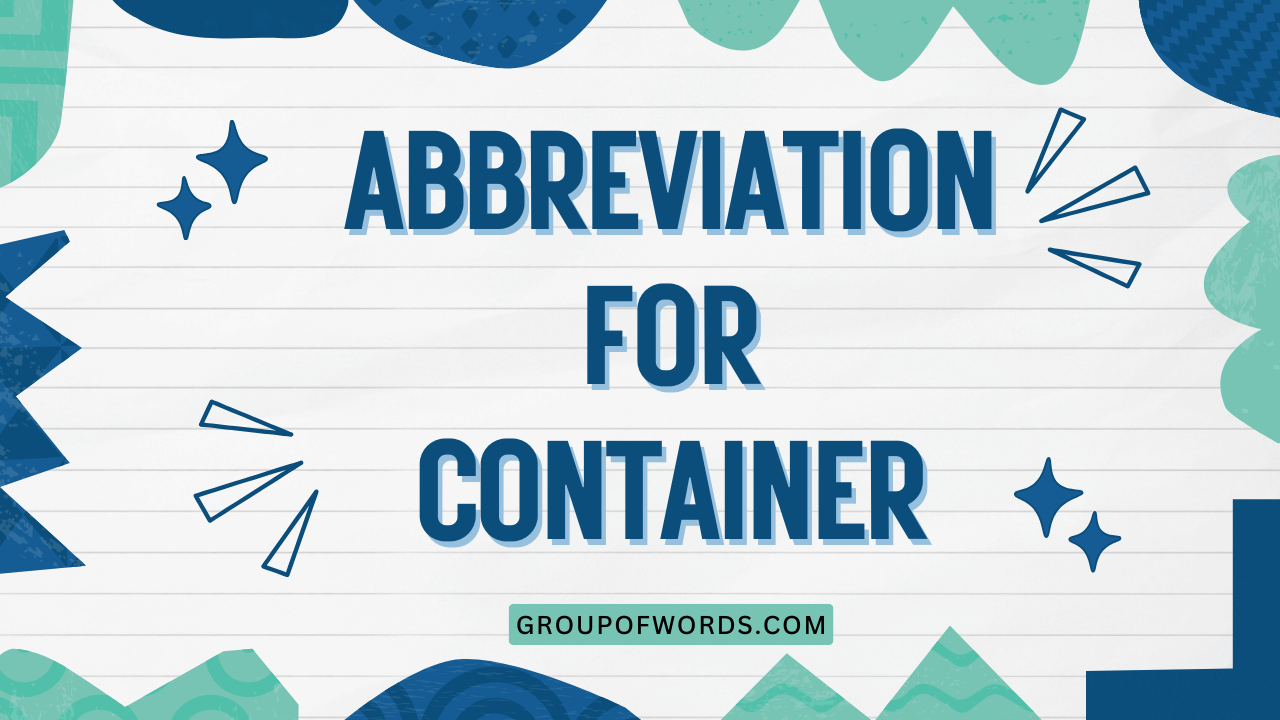Container Abbreviations: A Comprehensive Guide
Understanding abbreviations is crucial for efficient communication, especially in fields like shipping, logistics, and everyday commerce. This article provides a comprehensive guide to abbreviations used for containers, covering their definitions, types, usage rules, and common mistakes.
Whether you’re a student, a professional in the supply chain, or simply curious about container terminology, this guide will equip you with the knowledge to confidently interpret and use these abbreviations.
This knowledge is vital for clear communication, avoiding misunderstandings, and ensuring accuracy in documentation and transactions. This article will benefit students, logistics professionals, international traders, and anyone involved in the movement of goods.
Table of Contents
- Introduction
- Definition of Container Abbreviations
- Structural Breakdown of Container Abbreviations
- Types and Categories of Container Abbreviations
- Examples of Container Abbreviations
- Usage Rules for Container Abbreviations
- Common Mistakes with Container Abbreviations
- Practice Exercises
- Advanced Topics in Container Abbreviations
- Frequently Asked Questions
- Conclusion
Definition of Container Abbreviations
Container abbreviations are standardized codes used to represent various characteristics of shipping containers. These abbreviations typically denote the size, type, and ownership of the container.
They are essential for efficient tracking, handling, and documentation within the global supply chain. These codes are governed by international standards, primarily set by the International Organization for Standardization (ISO).
These abbreviations are crucial for several reasons. First, they provide a concise way to communicate complex information about a container.
Second, they facilitate automated data processing and tracking. Third, they ensure consistency and uniformity across different countries and organizations.
Without these abbreviations, managing the vast number of containers in global circulation would be incredibly difficult and prone to errors.
Container abbreviations can be classified based on the information they convey. Some abbreviations indicate the size and type of the container (e.g., 20GP for a 20-foot general-purpose container).
Others specify the equipment category (e.g., BK for a container with ventilation at the top). Still others identify the owner or operator of the container.
Each type of abbreviation plays a vital role in the overall container identification system.
Structural Breakdown of Container Abbreviations
Container abbreviations generally follow a structured format, allowing for quick identification of container characteristics. The most common structure includes elements for size, type, and equipment details.
Understanding this structure is key to deciphering and correctly using these abbreviations.
The size code typically indicates the length and height of the container. For example, ’22’ often signifies a 20-foot long container with a standard height.
The type code specifies the container’s purpose or design. ‘GP’ commonly stands for general purpose, while ‘RF’ denotes a refrigerated container.
Equipment codes provide further details about specific features of the container. These might include ventilation types, door configurations, or other special modifications.
These codes are often used in conjunction with size and type codes to provide a complete description of the container.
For example, consider the abbreviation ’22G1′. Here, ’22’ represents the size (20-foot long, standard height), ‘G’ indicates that it is a general-purpose container, and ‘1’ specifies the door arrangement.
This structured approach allows for a standardized and easily decodable system for container identification.
Types and Categories of Container Abbreviations
Container abbreviations can be grouped into several categories based on the information they convey. These categories include size and type codes, equipment category identifiers, and ownership codes.
Each category serves a distinct purpose in identifying and managing containers.
Size and Type Codes
Size and type codes are fundamental for identifying the dimensions and primary function of a container. The size code usually represents the length and height of the container in feet, while the type code specifies its purpose, such as general cargo, refrigerated goods, or liquids.
Common size codes include ’20’ (20 feet), ’40’ (40 feet), and ’45’ (45 feet). Type codes often used are ‘GP’ (general purpose), ‘HQ’ (high cube), ‘RF’ (refrigerated), and ‘OT’ (open top).
These codes are combined to form abbreviations like ’20GP’ (20-foot general purpose) or ’40HQ’ (40-foot high cube).
Understanding these codes is essential for selecting the appropriate container for specific cargo requirements. For example, perishable goods require refrigerated containers (RF), while oversized items may need open-top containers (OT).
The correct size and type code ensures that the container meets the cargo’s needs and complies with shipping regulations.
Equipment Category Identifiers
Equipment category identifiers provide additional details about the container’s specific features or modifications. These codes often indicate the presence of ventilation, special doors, or other unique characteristics that differentiate the container from standard models.
Examples of equipment category identifiers include ‘BK’ (ventilated container), ‘PL’ (platform container), and ‘TD’ (tank container). These codes are used in conjunction with size and type codes to provide a more comprehensive description of the container’s capabilities.
For instance, a ’40GP BK’ container would be a 40-foot general-purpose container with ventilation. Understanding these identifiers is crucial for handling specialized cargo that requires specific container features.
Proper identification ensures that the cargo is transported and stored safely and efficiently.
Ownership Codes
Ownership codes identify the company or organization that owns or operates the container. These codes are essential for tracking and managing containers throughout their lifecycle.
They are typically assigned by a central authority and are unique to each container owner.
Ownership codes usually consist of three letters followed by a serial number and a check digit. The three-letter code identifies the owner, while the serial number distinguishes individual containers within the owner’s fleet.
The check digit is a calculated value used to verify the accuracy of the code.
For example, ‘ABCU 1234567’ might represent a container owned by a company with the code ‘ABCU’. The serial number ‘1234567’ uniquely identifies that particular container.
These codes are crucial for tracking container movements, managing inventory, and ensuring accountability for container maintenance and repairs.
Examples of Container Abbreviations
To illustrate the practical application of container abbreviations, here are several examples categorized by the type of code. These examples demonstrate how size, type, and equipment codes are combined to form complete container descriptions.
Size and Type Code Examples
This table provides examples of common size and type codes used in container abbreviations. Understanding these codes is essential for interpreting container descriptions and ensuring proper cargo handling.
| Abbreviation | Description |
|---|---|
| 20GP | 20-foot General Purpose Container |
| 40GP | 40-foot General Purpose Container |
| 40HQ | 40-foot High Cube Container |
| 20RF | 20-foot Refrigerated Container |
| 40RF | 40-foot Refrigerated Container |
| 20OT | 20-foot Open Top Container |
| 40OT | 40-foot Open Top Container |
| 20FR | 20-foot Flat Rack Container |
| 40FR | 40-foot Flat Rack Container |
| 20PL | 20-foot Platform Container |
| 40PL | 40-foot Platform Container |
| 20TK | 20-foot Tank Container |
| 45GP | 45-foot General Purpose Container |
| 45HQ | 45-foot High Cube Container |
| 45RF | 45-foot Refrigerated Container |
| 10GP | 10-foot General Purpose Container |
| 30GP | 30-foot General Purpose Container |
| 20DC | 20-foot Dry Container |
| 40DC | 40-foot Dry Container |
| 40HC | 40-foot High Cube Container |
| 45HC | 45-foot High Cube Container |
The abbreviations listed above represent some of the most commonly used container types in global shipping. General purpose (GP, DC) containers are suitable for a wide range of dry goods, while high cube (HQ, HC) containers provide additional vertical space.
Refrigerated (RF) containers are essential for transporting perishable items, and open-top (OT) containers are designed for oversized or awkwardly shaped cargo.
Equipment Category Identifier Examples
This table provides examples of equipment category identifiers and their corresponding descriptions. These identifiers provide additional details about the container’s specific features or modifications.
| Abbreviation | Description |
|---|---|
| BK | Ventilated Container (Ventilation at the top) |
| VT | Ventilated Container (Ventilation at the bottom) |
| BU | Ventilated Container (Ventilation at the top and bottom) |
| RS | Refrigerated Container with integral machinery |
| HR | Heated Container |
| TN | Tank Container for non-hazardous liquids |
| TG | Tank Container for hazardous gases |
| TD | Tank Container for hazardous dry goods |
| PF | Platform Container with complete floor |
| PS | Platform Container with incomplete floor |
| OT | Open Top Container |
| FR | Flat Rack Container |
| SD | Specific design container |
| DG | Dangerous Goods Container |
| SN | Suitable for solid, dry bulk cargo, non-pressurized |
| HC | High Cube Container |
| RE | Reefer Container |
| PL | Platform Container |
| PC | Closed Ventilated Container |
| VH | Ventilated Container with humidity control |
These equipment category identifiers are crucial for specifying the precise capabilities of a container. Ventilated containers (BK, VT, BU) are used for goods that require air circulation, while refrigerated containers (RS, HR) maintain specific temperature conditions.
Tank containers (TN, TG, TD) are designed for transporting liquids or gases, and platform containers (PF, PS) are suitable for oversized or heavy cargo.
Combined Abbreviation Examples
This table provides examples of combined container abbreviations, showcasing how size, type, and equipment codes are used together to form complete container descriptions.
| Abbreviation | Description |
|---|---|
| 20GP BK | 20-foot General Purpose Container with Ventilation at the top |
| 40HQ VT | 40-foot High Cube Container with Ventilation at the bottom |
| 20RF RS | 20-foot Refrigerated Container with integral machinery |
| 40OT FR | 40-foot Open Top Container with Flat Rack Design |
| 20TK TN | 20-foot Tank Container for non-hazardous liquids |
| 40GP BU | 40-foot General Purpose Container with Ventilation at the top and bottom |
| 45HQ HC | 45-foot High Cube Container (High Cube indicated twice for emphasis) |
| 20FR PL | 20-foot Flat Rack Container with Platform Design |
| 40RF HR | 40-foot Refrigerated Container with Heating Capability |
| 20GP SD | 20-foot General Purpose Container with Specific Design |
| 40HQ DG | 40-foot High Cube Container for Dangerous Goods |
| 20RF VH | 20-foot Refrigerated Container with humidity control |
| 40OT SD | 40-foot Open Top Container with Specific Design |
| 20TK TG | 20-foot Tank Container for hazardous gases |
| 40GP SN | 40-foot General Purpose Container Suitable for solid, dry bulk cargo |
| 45HQ RE | 45-foot High Cube Reefer Container |
| 20PL PF | 20-foot Platform Container with Complete Floor |
| 40RF PC | 40-foot Refrigerated Container, Closed Ventilated |
| 20GP VT | 20-foot General Purpose Container with Ventilation at the bottom |
| 40HQ BK | 40-foot High Cube Container with Ventilation at the top |
| 45RF BU | 45-foot Refrigerated Container with Ventilation at the top and bottom |
These combined abbreviations provide a clear and concise description of each container’s characteristics. Understanding how these codes are combined is essential for accurate container identification and efficient cargo management.
For example, a ’20GP BK’ container is a standard 20-foot container suitable for general cargo that also requires ventilation at the top of the container.
Usage Rules for Container Abbreviations
Proper usage of container abbreviations is crucial for clear communication and accurate documentation. Several rules govern the correct application of these abbreviations, including standard notation, contextual usage, and industry standards.
Standard Notation
Container abbreviations should follow a standardized notation to ensure consistency and avoid ambiguity. The size code typically precedes the type code, and equipment identifiers are often appended to the end.
For example, ’20GP BK’ follows the standard notation of size, then type, then equipment.
It’s important to use uppercase letters for all abbreviations to maintain uniformity. Spaces should be used sparingly, typically only between the main components of the abbreviation (e.g., ’20 GP’ instead of ’20GP’).
Consistency in notation is vital for accurate data processing and communication.
Following the standard notation ensures that container descriptions are easily understood and correctly interpreted by all parties involved in the shipping process. Deviations from the standard can lead to confusion, errors, and delays.
Contextual Usage
The meaning of container abbreviations can sometimes vary depending on the context. It’s essential to consider the specific industry or application when interpreting these abbreviations.
For example, a particular equipment code might have a slightly different meaning in the context of refrigerated containers compared to general-purpose containers.
In some cases, additional codes or identifiers might be used to provide further clarification. These supplemental codes can help to disambiguate the meaning of the primary abbreviations and ensure accurate communication.
Always consider the surrounding information and the specific context when interpreting container abbreviations.
Understanding the contextual usage of container abbreviations is crucial for avoiding misunderstandings and ensuring that the correct container is selected for the intended purpose. Always verify the meaning of abbreviations in the specific context of their use.
Industry Standards
Container abbreviations are governed by industry standards set by organizations such as the International Organization for Standardization (ISO). These standards define the specific codes used for different container types and equipment features.
Adhering to these standards is essential for ensuring interoperability and consistency across the global supply chain.
It’s important to stay updated on the latest versions of these standards, as they can be updated periodically to reflect changes in container technology and industry practices. Regularly consulting the ISO standards and other relevant industry guidelines is crucial for maintaining accurate and up-to-date knowledge of container abbreviations.
Compliance with industry standards ensures that container descriptions are universally understood and that containers can be seamlessly integrated into the global transportation network. Adherence to these standards is vital for efficient and reliable container management.
Common Mistakes with Container Abbreviations
Despite the standardized nature of container abbreviations, several common mistakes can occur in their usage. These mistakes can lead to confusion, errors, and delays in the shipping process.
Awareness of these common pitfalls is essential for avoiding them.
One common mistake is using incorrect or outdated abbreviations. Container technology and industry standards can change over time, so it’s important to ensure that you are using the most current and accurate codes.
Another frequent error is misinterpreting the meaning of abbreviations, particularly equipment category identifiers. Always double-check the meaning of abbreviations to ensure that you understand their precise implications.
Another common mistake is failing to follow the standard notation. Using incorrect spacing, capitalization, or order of codes can lead to confusion and misinterpretation.
Always adhere to the standard notation guidelines to ensure clarity and consistency. Here are some examples of incorrect vs. correct usage:
| Incorrect | Correct | Explanation |
|---|---|---|
| 20 gp | 20GP | Incorrect spacing |
| 40Hq | 40HQ | Incorrect capitalization |
| GP20 | 20GP | Incorrect order of codes |
| 40 High Cube | 40HQ | Using full words instead of abbreviations |
| Reefer 20 | 20RF | Using full words instead of abbreviations and incorrect order |
| 20GPventilated | 20GP BK | Missing space and using full word instead of abbreviation |
| 40HQ Vent | 40HQ VT | Using shortened full word instead of correct abbreviation |
| 20generalpurpose | 20GP | No space and using full word |
| 20 gp BK | 20GP BK | Extra space |
| 40HC cube | 40HQ | Incorrect abbreviation and using full word |
Avoiding these common mistakes is crucial for ensuring accurate container identification and efficient cargo management. Always double-check your abbreviations, follow the standard notation, and stay updated on the latest industry standards.
Practice Exercises
To test your understanding of container abbreviations, complete the following exercises. These exercises cover various aspects of container identification, including size, type, and equipment codes.
Exercise 1: Identify the container type based on the abbreviation.
| Question | Answer |
|---|---|
| What type of container is ’40GP’? | 40-foot General Purpose Container |
| What type of container is ’20RF’? | 20-foot Refrigerated Container |
| What type of container is ’40HQ’? | 40-foot High Cube Container |
| What type of container is ’20OT’? | 20-foot Open Top Container |
| What type of container is ’40FR’? | 40-foot Flat Rack Container |
| What type of container is ’45HQ’? | 45-foot High Cube Container |
| What type of container is ’20PL’? | 20-foot Platform Container |
| What type of container is ’40TK’? | 40-foot Tank Container |
| What type of container is ’20DC’? | 20-foot Dry Container |
| What type of container is ’40HC’? | 40-foot High Cube Container |
Exercise 2: Decode the combined container abbreviations.
| Question | Answer |
|---|---|
| What does ’20GP BK’ mean? | 20-foot General Purpose Container with Ventilation at the top |
| What does ’40HQ VT’ mean? | 40-foot High Cube Container with Ventilation at the bottom |
| What does ’20RF RS’ mean? | 20-foot Refrigerated Container with integral machinery |
| What does ’40OT FR’ mean? | 40-foot Open Top Container with Flat Rack Design |
| What does ’20TK TN’ mean? | 20-foot Tank Container for non-hazardous liquids |
| What does ’40GP BU’ mean? | 40-foot General Purpose Container with Ventilation at the top and bottom |
| What does ’45HQ HC’ mean? | 45-foot High Cube Container (High Cube indicated twice for emphasis) |
| What does ’20FR PL’ mean? | 20-foot Flat Rack Container with Platform Design |
| What does ’40RF HR’ mean? | 40-foot Refrigerated Container with Heating Capability |
| What does ’20GP SD’ mean? | 20-foot General Purpose Container with Specific Design |
Exercise 3: Correct the incorrect container abbreviations.
| Question | Answer |
|---|---|
| Correct the abbreviation: ’20 gp’ | 20GP |
| Correct the abbreviation: ’40Hq’ | 40HQ |
| Correct the abbreviation: ‘GP20’ | 20GP |
| Correct the abbreviation: ’40 High Cube’ | 40HQ |
| Correct the abbreviation: ‘Reefer 20’ | 20RF |
| Correct the abbreviation: ’20 generalpurpose’ | 20GP |
| Correct the abbreviation: ’40HC cube’ | 40HQ |
| Correct the abbreviation: ’20GPventilated’ | 20GP BK |
| Correct the abbreviation: ’40HQ Vent’ | 40HQ VT |
| Correct the abbreviation: ’45 hq’ | 45HQ |
These practice exercises provide a hands-on opportunity to reinforce your understanding of container abbreviations. By completing these exercises, you can identify areas where you need further review and improve your overall proficiency in using these codes.
Advanced Topics in Container Abbreviations
For advanced learners, several specialized aspects of container abbreviations warrant further exploration. These topics include abbreviations for reefer containers, tank containers, and specialized equipment codes.
Understanding these advanced topics requires a deeper understanding of container technology and industry practices.
Reefer Container Abbreviations
Reefer containers, or refrigerated containers, have specific abbreviations to denote their cooling capabilities and temperature control systems. These abbreviations are crucial for identifying containers suitable for transporting perishable goods.
Common reefer container abbreviations include ‘RF’ (refrigerated), ‘RS’ (refrigerated with integral machinery), and ‘HR’ (heated container).
Additionally, reefer containers may have equipment category identifiers that specify the type of refrigeration system or temperature control features. These identifiers provide further details about the container’s ability to maintain specific temperature conditions.
Understanding these abbreviations is essential for ensuring that perishable goods are transported safely and efficiently.
For example, a ’40RF RS’ container is a 40-foot refrigerated container with an integral refrigeration unit. This type of container is ideal for transporting temperature-sensitive goods over long distances.
Tank Container Abbreviations
Tank containers are specialized containers designed for transporting liquids, gases, or dry bulk materials. These containers have specific abbreviations to denote the type of substance they are designed to carry.
Common tank container abbreviations include ‘TK’ (tank container), ‘TN’ (tank container for non-hazardous liquids), ‘TG’ (tank container for hazardous gases), and ‘TD’ (tank container for hazardous dry goods).
These abbreviations are crucial for identifying containers suitable for transporting specific types of materials. Tank containers for hazardous materials must meet strict safety regulations and require specialized handling procedures.
Understanding these abbreviations is essential for ensuring the safe and compliant transport of hazardous substances.
For example, a ’20TK TG’ container is a 20-foot tank container designed for transporting hazardous gases. This type of container must be handled with extreme care and comply with all applicable safety regulations.
Specialized Equipment Codes
In addition to the standard size, type, and equipment codes, there are several specialized equipment codes used to denote unique container features or modifications. These codes are often specific to certain industries or applications and may not be universally recognized.
Examples include codes for containers with specialized door configurations, ventilation systems, or internal fittings.
Understanding these specialized equipment codes requires a deep understanding of container technology and industry practices. It’s important to consult industry-specific guidelines and documentation to accurately interpret these codes.
Proper identification of specialized container features is crucial for ensuring that the container is suitable for its intended purpose.
For example, a container with a specialized ventilation system might have a unique equipment code to denote its specific features. This code would provide additional information about the container’s ability to maintain specific environmental conditions.
Frequently Asked Questions
Here are some frequently asked questions about container abbreviations, along with detailed answers to address common concerns and misconceptions.
- What is the purpose of container abbreviations?
Container abbreviations provide a standardized and concise way to identify the size, type, and features of shipping containers. They facilitate efficient communication, tracking, and documentation within the global supply chain.
- Who sets the standards for container abbreviations?
The International Organization for Standardization (ISO) sets the primary standards for container abbreviations. These standards are updated periodically to reflect changes in container technology and industry practices.
- What are the most common container size codes?
The most common container size codes are ’20’ (20 feet), ’40’ (40 feet), and ’45’ (45 feet), representing the length of the container.
- What do the type codes ‘GP’, ‘HQ’, and ‘RF’ stand for?
‘GP’ stands for general purpose, ‘HQ’ stands for high cube, and ‘RF’ stands for refrigerated. These codes indicate the primary function of the container.
- How are equipment category identifiers used in container abbreviations?
Equipment category identifiers provide additional details about the container’s specific features or modifications, such as ventilation, special doors, or other unique characteristics.
- What is the standard notation for container abbreviations?
The standard notation typically involves placing the size code first, followed by the type code, and then any equipment category identifiers. For example, ’20GP BK’.
- What are some common mistakes to avoid when using container abbreviations?
Common mistakes include using incorrect or outdated abbreviations, misinterpreting the meaning of abbreviations, and failing to follow the standard notation.
- Where can I find the most up-to-date information on container abbreviations?
You can find the most up-to-date information on container abbreviations by consulting the ISO standards and other relevant industry guidelines.
- How important are container abbreviations in the logistics industry?
Container abbreviations are extremely important in the logistics industry. They help to streamline communication, reduce errors, and ensure that cargo is handled and transported efficiently. Without these abbreviations, the global supply chain would be much more complex and prone to delays.
- Are there different abbreviation standards in different countries?
While the ISO sets the international standard, some regions or companies may have their own specific internal codes or variations. However, adherence to the ISO standard ensures global interoperability and understanding.
Conclusion
Mastering container abbreviations is essential for anyone involved in the global supply chain, from logistics professionals to international traders. This comprehensive guide has provided a detailed overview of container abbreviations, covering their definitions, types, usage rules, common mistakes, and advanced topics.
By understanding these concepts, you can confidently interpret and use container abbreviations in various contexts.
Remember to always adhere to the standard notation, stay updated on the latest industry standards, and double-check your abbreviations to avoid errors. With practice and attention to detail, you can become proficient in using container abbreviations and contribute to more efficient and reliable cargo management.
Continue to practice and expand your knowledge of container abbreviations to further enhance your skills and expertise in the field of logistics and international trade. The ability to accurately interpret and use these codes is a valuable asset that will serve you well in your career.






